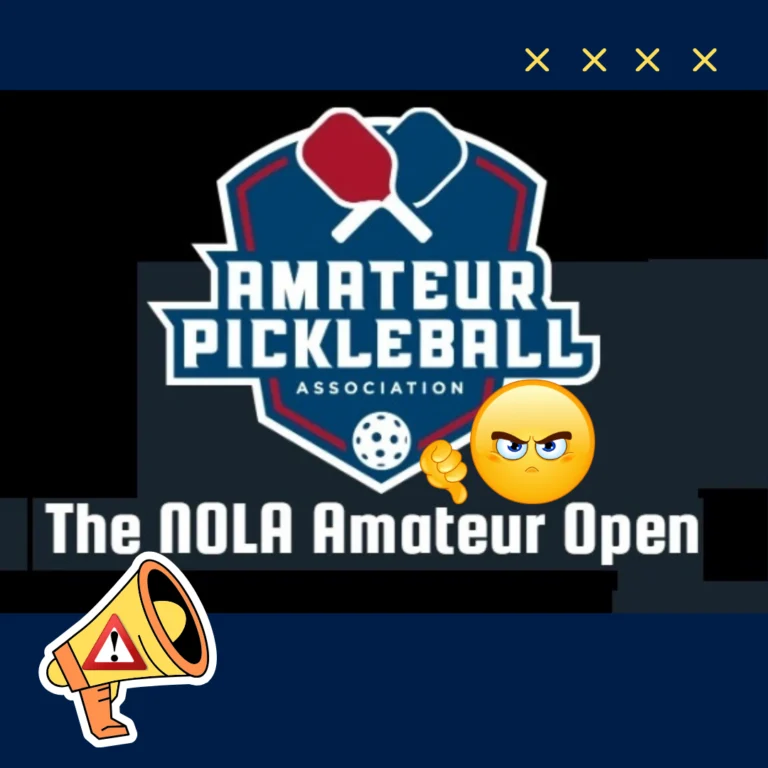Dynamic Universal Pickleball Rating
The Evolution of DUPR: A Journey Marked by Promise and Uncertainty
The Dynamic Universal Pickleball Rating (DUPR) system has been a focal point of innovation and ambition within the pickleball community. The journey of DUPR began with a vision. It aimed to create a fair, transparent, and accurate rating system. From its inception to the present and beyond, it embodies this quest. However, the path has been rocky. Promises, adjustments, and missteps have introduced uncertainty, challenging players.
The Genesis and Evolution: A Mixed Legacy
The Early Promise of Accuracy
DUPR was founded with a noble goal. It sought to change how pickleball skills were rated. The aim was a system dynamic and true to performance. At first, its weekly updates and heuristic approach were groundbreaking. However, these methods added complexity that the community did not favor. The idea of an adaptable, accurate system was appealing. Yet, its implementation frequently fell short of expectations.
Transitioning with Ambition
The move to instant updates came from community feedback. It aimed to align performance with ratings more closely. Yet, this change exposed the system’s flaws. Technical issues and simplifying the Dynamic Universal Pickleball Rating algorithm raised doubts. The goal was ambitious. However, creating a dependable rating system proved complex. Moreover, instant updates sometimes resulted in less reliable ratings.
The Present: Innovations Amidst Skepticism
Recent DUPR updates have sparked both excitement and doubt. New features like real-time updates aim to boost transparency and engagement. However, constant algorithm tweaks have frustrated some players. Simplifying the algorithm was meant to ease access but sometimes neglects performance nuances.
The skepticism isn’t without merit. Many players, including members of the New Orleans Pickleball Club, have seen their DUPR ratings fluctuate wildly due to algorithm changes that were later acknowledged to be flawed. This history of adjustments, while aimed at improvement, has understandably led to a cautious outlook on the system’s reliability.
A New Chapter: Strategic Leadership with an Eye on the Past
The Dynamic Universal Pickleball Rating System (DUPR) has unveiled major updates to improve rating accuracy and reliability. These changes hopefully represent a big advancement for pickleball. They aim to better the experience for players of all levels. Below is a detailed look at these updates and their potential effects on ratings.
The acquisition of Dynamic Universal Pickleball Rating (DUPR) by a new leadership group, including figures like David Kass and Andre Agassi, marks a potentially transformative chapter. This move brings hope and a renewed commitment to addressing the system’s challenges. Yet, the skepticism remains. The promises of innovation, transparency, and community engagement are welcome, but the proof will be in the pudding. The question lingers: Can this new chapter truly rectify past missteps and deliver on the promise of a fair and accurate rating system?
Understanding the New DUPR Algorithm Updates
Points Matter
The DUPR rating system’s original update on the role of a match’s victory margin marks a thoughtful evolution from its predecessors. Moving away from the previous model, where the outcome’s margin could counterintuitively affect a player’s rating, the new approach offers a straightforward principle: securing a win guarantees a rating boost, while a defeat ensures a decrease. The magnitude of this adjustment is now directly tied to the victory margin—a decisive triumph (e.g., 11-0) will significantly elevate your rating more so than a narrow win (e.g., 11-9).
The latest DUPR update significantly enhances transparency in the rating process. Players now know the direction of rating changes, though not exact numbers. This change simplifies the system for users. It clarifies that all victories positively impact ratings, regardless of the score margin. This effort makes the rating process more accessible. It aims to demystify how ratings work, encouraging informed participation.
From my perspective, this update strikes a balance between the overly simplistic approach of the past and the complexity of the version before last. It edges closer to achieving more accurate player ratings by acknowledging the importance of match margins. However, I believe there’s room for further refinement. Drawing parallels with the point spread system in football, which I see as a benchmark for accuracy, suggests that another tweak could enhance DUPR’s precision even further. The challenge lies in maintaining this new level of transparency while integrating expectations around match outcomes beforehand. Finding a way to communicate these expectations clearly to players before they step onto the court is the next critical step in DUPR’s ongoing quest for the perfect rating system.
Recency Matters
Recent matches now impact your rating more than older ones. This change makes ratings better reflect current skill levels. It emphasizes your latest performance on the court.
Total Match Count Matters
The more matches you’ve played, the less your rating will fluctuate with each additional match. This stability rewards players who consistently participate in DUPR-rated matches, reducing the impact of any single match on their overall rating.
Every Match Matters
The DUPR rating system values every match in determining a player’s rating. This includes games against unrated or new players. It highlights an inclusive philosophy. Every competitive match matters, no matter the opponent’s rating. This inclusivity boosts engagement among all skill levels in pickleball.
However, it’s crucial to acknowledge a past challenge that highlighted a major flaw in the DUPR rating system concerning how unrated players were initially assessed. In its early stages, DUPR set the starting expectation for unrated players at a 3.5 level. A subsequent update adjusted this starting point to 2.5, leading to considerable rating drops for players who lost to these newly rated individuals. This change often did not accurately reflect the true skill levels of the unrated players, many of whom were likely more skilled than a 2.5 rating would suggest. The impact of this decision underscored the delicate balance DUPR must maintain in accurately assessing player skills while fostering a fair and competitive environment.
In light of these historical challenges, the current emphasis on ensuring every match matters represents both a continuation of DUPR’s inclusive philosophy and a response to past criticisms. By valuing each game played, DUPR aims to create a more dynamic and responsive rating system. However, this approach also carries the responsibility of continuously refining how new or unrated players are integrated into the system to avoid repeating past inaccuracies. As DUPR evolves, finding the optimal method to accurately assess and incorporate unrated players into the competitive landscape remains a critical area for future adjustments, ensuring that every match truly reflects the skill levels involved.
Looking Ahead: Cautious Optimism
The future of DUPR is a narrative of cautious optimism. The system’s journey is a reflection of the pickleball community’s desire for a rating system that is both reflective of true skill and adaptable to the sport’s dynamic nature. Yet, the path to achieving this ideal has been anything but straightforward. As DUPR navigates its latest chapter under new leadership, the community watches with a hopeful yet critical eye, wondering if this time, the promises will translate into a system that they can trust and rely on.
Impact on Current and Future Ratings
For Current Ratings
These updates will be retroactively applied to all match results on the DUPR platform, as well as to future match submissions. This means your current rating may see adjustments to align with the new algorithm criteria. For players who’ve been active and have a history of both tight and decisive matches, you might notice changes in your rating that reflect the new emphasis on match margin, recency, and total count.
For Future Match Submissions
Moving forward, every match you play will be evaluated under these updated criteria. This means that to maintain or improve your rating, you’ll need to focus not just on winning, but on how convincingly you win, staying active to leverage the recency factor, and building a robust match history to stabilize your rating.
Navigating the Changes
While DUPR’s updates aim to enhance the rating system’s accuracy and player experience, they also introduce new dynamics for players to consider. The emphasis on match margin and recency may encourage more competitive play and strategic participation in matches. However, it’s essential to approach these changes with an understanding that the system is designed to evolve and improve over time, based on player feedback and data analysis.
Skepticism and Optimism
Given DUPR’s history of updates and the continuous quest for the perfect rating algorithm, some skepticism among players is understandable. The impact of these changes on individual ratings, especially in the short term, may vary widely, leading to mixed reactions within the community. However, DUPR’s commitment to refining its system and the introduction of these updates signal a positive step towards a more accurate and reliable rating system that benefits the entire pickleball community.
A Journey Continues with Guarded Hope
The recent updates to DUPR mark a major change in rating calculations. They aim to improve fairness and accuracy in rankings. As DUPR evolves, players should keep up and adapt. They’re also urged to join discussions on its development. DUPR seeks to make pickleball more competitive and fun for all.
The evolution of the Dynamic Universal Pickleball Rating system is a complex tale of ambition, innovation, and the challenges of implementing a universally accepted rating system. As we look to the future, the community’s engagement and feedback will be crucial in shaping a system that truly meets their needs. Yet, the skepticism born of past experiences remains a shadow over DUPR’s promises of improvement. Only time will tell if DUPR can finally deliver on its potential, turning cautious optimism into unreserved confidence.







